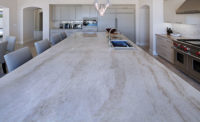The national statistics processed by the Internazionale Marmi e Macchine research office, based on Istat, emphasize how in its exports of quality materials (marble, granite, travertine and other stones, both raw materials and finished products, and excluding chips, slates and powders) the best performance is shown by marble, both raw materials and finished products, for which increases are recorded both in terms of value and quantity.
In fact in 2012, 1 million and 380 thousand tons of marblewere exportedin blocks and slabs, showing a +7.2% increase from 2011, for a value of over 305 million Euros, showing a growth trend of close to +6%. The average unit value decreased slightly though, from 224 Euros per ton to 221 Euros.
Excellent results were also recorded for exports of finished marble products which in 2012 reached 885,119 tonsfor 815,221,431 million Euros, an increase of almost +6% in quantity and over +17% in value and an increase in the average unit valueof +11.2% which today is equal to 921 Euros per ton.
A different scenario in the granite sector, however, where in 2012, there was a reduction in quantities exported but an increase in value. Exports stood at 158.8 thousand tons of blocks and slabs, showing a decrease of almost 2%, for a value of around 41 million Euros, showing instead a +3.7% increase compared to 2011. At the same time, there was a -2.35% drop in quantitiesof granite finished products exported too,alongside an increase in value of 3.2%, for a total of 599,000 tons exported for almost 549 million Euros.
The excellent national performance was partly dictated by exports to the American continent, in particular to the U.S. and Canada which in 2012 absorbed 225,193 tons of quality materials, in particular finished products in both marble and granite, for a total value of 337.5 million Euros. This shows growth of +14. 6% in quantity and +27% in value compared to 2011, with a consequent increase in the average unit value of +11% which is the equivalent of almost 1,500 Euros per ton.
Exports to the Far East recorded a positive trend too, in particular to China, India and Taiwan, where one third of Italian exports of quality materials were directed in 2012. Overall exports to the Far East amounted to over 1,024,000 tons of quality materials, in particular marble in blocks, for a value of over 313 million Euros, showing a growth of near to +7% both in terms of quantity and value.
"Despite the fact that almost all the figures have a'+' sign in front of them,they should be read and interpreted carefully as they show national results," said the IMM Chairman Giorgio Bianchini. "And only once national export trends have been compared to those of the individual districts will we be in a position to give a more precise assessment of the national and local performance. However, what is clear is that there has been a recovery on certain markets such as the North American market and that there is a positive trend underway in the Far East while Europe shows contrasting signs obviously due to the crisis mostly affecting certain Euro countries. Over the next few weeks we will be looking more closely at the statistics and comparing them with the results from the economic analysis that we are conducting on a national scale together with a significant sample of companies in the industry."
IMM General Manager, Paris Mazzanti, also advises careful reading of the statistics as, "looking at a few of the figures from the economic analysis conducted by our research office, approximately 67% of Italian stone companies have declared a downturn in the Italian turnover while 23.6% have said it is stationary. It still has to be ascertained; therefore, whether or not the increase in foreign turnover completely compensates for the drop in domestic demand yet, judging by what a good number of companies say, the answer would appear to be negative."
A positive piece of news is that, following the end of the "Arab Spring" crisis, in 2012 a recovery was recorded in marble exports to certain countries in North Africa, Egypt and Libya first and foremost. Italy exported 78,000 tons to Egypt for a value of approximately12 millionEuros, thereby returning to 2008 volumes and values. To Libya it exported over 104,000tons for a value of 12.4 million Euros with a strong increase on 2011 (when exports came to a standstill) of +175% in quantity and +154% in value.
Exports continued their lively growth to Saudi Arabiatoo, recording exports totalling 112 million Euros and showing a two-figure increase (61%), for an average unit value per ton of 651 Euros.
Worthy of note too is the growth of Italian exports to central-southern Africa. The figures show reduced quantities and values, as exports to these countries amounted to 9,400 tons for 7.6 million Euros overall, but an increase in volume of +20.5% and value of +21.4%. The countries which most increased imports from Italy are in order of importance in terms of quantity, Angola, Congo and Kenya.
What dropped, however, both in terms of quantity (-4.4%) and value (-1.6%), were quality exportsto countries of the European Union which accounted for 639,000 tons for an overall value of almost 472 million Euros.
The German market, a fundamental market for Italian stone, recorded a downturn in exports in terms of quantity (-1.76%) but with an increase in value of +2.6% for the 243,000 tons of quality materials imported for a value of 168 million Euros.
Exports to France, however, grew, especially of finished products in marble and other stones, for a total of 102,000 tons and a value of 78 million Euros, showing an upward trend of +6% in quantity and +10.6% in value.
Exports to the Russian Federation continued to increase too, in particular very high quality marblefinished productswhose average unit value was over 2300 Euros per ton. In 2012 Italy exported 17,000 tons of finished products to this country for a value of over 40 million Euros, showing an increase of +14.2% in quantity and approximately +9% in value on 2011.
Marble and granite imports in 2012: another minus mark
Imports, especially of raw materials -- which are indicative to understand and evaluate the trust and order books of Italian companies -- continued to record negative figures for almost all items, in particular for granite as raw materials and finished products.
In 2012, Italy imported 1,490,333 tons of stone, down by -15% on 2011 and for a value of 393,964,783 million Euros, showing a -6% decrease.
The reductionin imports is higher for granite, both in blocks and slabs (-16%), and finished products (-7%), with a reduction in particular fromBrazil, India, China and South Africa.
As regards India, the leading supplier for the Italian stone industry, Italian companies imported 223,000 tons of quality materialsfor a value of 62 millionEuros, showing a decrease on 2011 of -25.4% in quantity and -18.6% in value.
What is interesting, however, is the increase in imports from new suppliers: Mozambique, Tunisia and Albania.
From Mozambique Italy imported 47,000 tons of granite in blocks and slabs for a value of 13.3 million Euros, up on 2011 figures by +13.8% in quantity and +3.9% in value. From Tunisia it imported 62,000 tons of marble in blocks and slabs for a value of 6.7 million Euros, showing +5% in quantity and +16.2% in value. From Albania, it imported mostly granite in blocks and slabs, 47,600 tons for a value of over 4 million Euros, showing an increase of +10% in quantity and +5.8% in value.
What should be emphasized, however, is that the 2012 trade balance for the national stone industry records a positive figure of over1.4 billion Euros.





